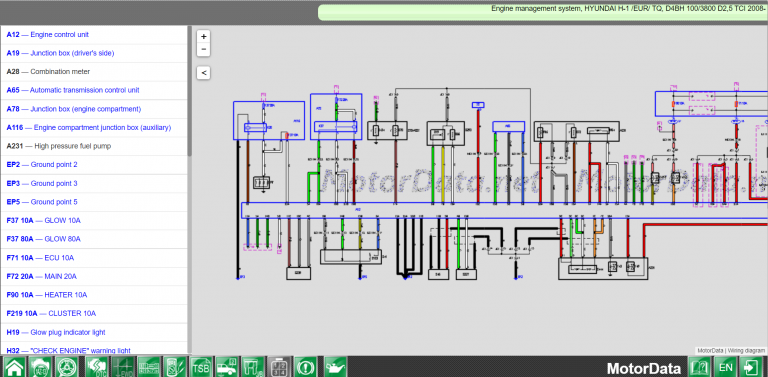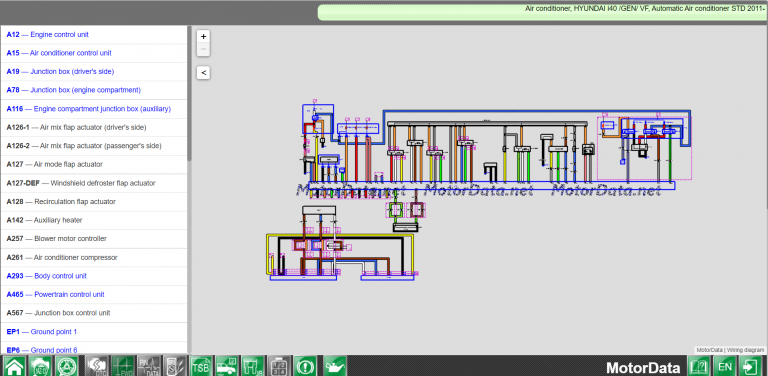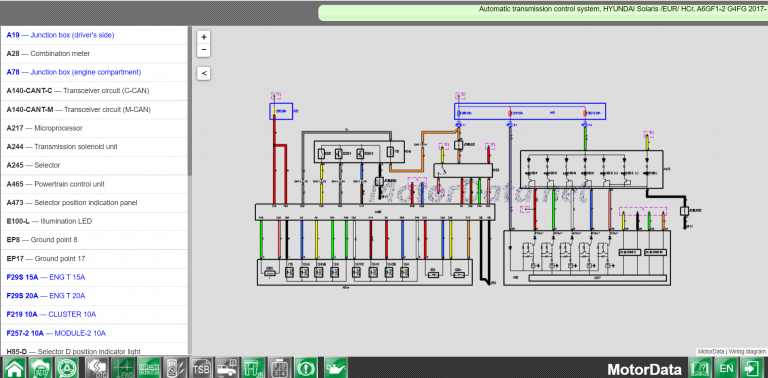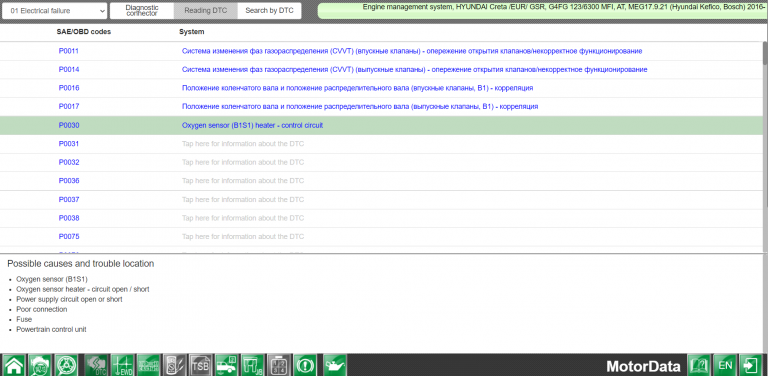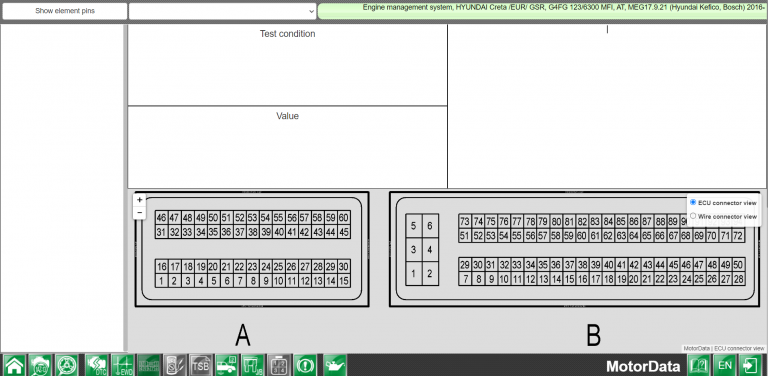MotorData Professional —
a diagnostic software for Hyundai vehicles
MotorData Professional is a software for repairing and diagnosing Hyundai vehicles, incl. popular models Creta, Elantra, Palisade, Santa FE, Solaris, Sonata, and Tucson. MotorData is a professional information system for diagnosticians and auto electricians, which contains wiring diagrams, error codes, typical malfunctions, pinouts and control unit signals. The cloud program will speed up the diagnostics of Korean cars and increase the speed of vehicle repairs. With MotorData Professional it is good to diagnose Hyundai on a laptop and computer. To diagnose Korean models using a smartphone and an ELM327 adapter with OBD2, we recommend downloading the MotorData OBD ELM autoscanner app for free.
Advantages of MotorData Professional
- Colored and interactive wiring diagrams with wire tracing capability;
- Diagnostic trouble codes, manufacturer’s internal codes, Flash codes for Hyundai;
- TSB (Technical Service Bulletin) of Hyundai cars;
- Pindata, pinouts of control units, reference waveforms
Professional diagnostic software for Korean cars
MotorData Professional is a popular diagnostic tool for checking Hyundai vehicles. Tracing the wires on a colored wiring diagram greatly facilitates diagnostic work. An auto electrician simply finds the desired element on the diagram and traces the entire circuit. The specialist can easily scale the diagram and move it. Interactivity will allow the user to go through several screens of the program at once and see right there, for example, the pinout of Hyundai control units. Printing of the wiring diagram in two clicks is available. The diagnostician will always have at hand information on common errors (DTC) OBD-II (P0, P1, P2, P3, U0, U1, U2, C, B). As well as known malfunctions for Hyundai models, data on grounding points locations, fuse/relay/junction boxes and element check procedures.
Wiring diagram examples in MotorData
Hyundai DTCs you can read with MotorData
- P0001: Fuel volume regulator control – circuit open
- P0002: Fuel volume regulator control – circuit range/performance
- P0003: Fuel volume regulator control – low voltage
- P0004: Fuel volume regulator control – high voltage
- P0005: Fuel shut-off valve – circuit open
- P0006: Fuel shut-off valve – signal low
- P0007: Fuel shut-off valve – signal high
- P0011: Intake camshaft position, left front (B1) – timing over-advanced / system performance
- P0012: Intake camshaft position, left front (B1) – timing over retarded
- P0014: Camshaft position actuator, exhaust/right/rear (B1) – timing over-advanced / system performance
- P0016: Crankshaft position/camshaft position, bank 1 sensor A – mismatch
- P0017: Crankshaft position/camshaft position, bank 1 sensor B – correlation
- P0019: Crankshaft position/camshaft position, bank 2 sensor B – correlation
- P0030: Heated oxygen sensor 1, bank 1, heater control – circuit malfunction
- P0031: Heated oxygen sensor 1, bank 1, heater control – low voltage
- P0032: Heated oxygen sensor 1, bank 1, heater control – high voltage
- P0036: Heated oxygen sensor 2, bank 1, heater control – circuit malfunction
- P0037: Heated oxygen sensor 2, bank 1, heater control – low voltage
- P0038: Heated oxygen sensor 2, bank 1, heater control – high voltage
- P0042: Heated oxygen sensor 3, bank 1, heater control – circuit malfunction
- P0043: Heated oxygen sensor 3, bank 1, heater control – low voltage
- P0044: Heated oxygen sensor 3, bank 1, heater control – high voltage
- P0068: Manifold absolute pressure (MAP) sensor/mass air flow (MAF) sensor – throttle position correlation
- P0069: Intake manifold absolute pressure sensor / barometric pressure sensor – correlation
- P0075: Intake valve control solenoid, bank 1 – circuit malfunction
- P0076: Intake valve control solenoid, bank 1 – low voltage
- P0077: Intake valve control solenoid, bank 1 – high voltage
- P0078: Exhaust valve control solenoid, bank 1 – circuit malfunction
- P0079: Exhaust valve control solenoid, bank 1 – low voltage
- P0080: Exhaust valve control solenoid, bank 1 – high voltage
- P0087: Fuel rail/system pressure – too low
- P0088: Fuel rail/system pressure – too high
- P0093: Fuel system leak – large leak detected
- P0094: Fuel system leak – small leak detected
- P0100: Air flow sensor (mass – MAF) / (volumetric – VAF) – circuit malfunction
- P0101: Air flow sensor (MAF)/(VAF) – range/performance
- P0102: Air flow sensor (MAF)/(VAF) – input signal low
- P0103: Air flow sensor (MAF)/(VAF) – input signal high
- P0106: Intake manifold absolute pressure sensor / barometric pressure sensor – range/performance
- P0107: Intake manifold absolute pressure sensor / barometric pressure sensor – signal low
- P0108: Intake manifold absolute pressure sensor / barometric pressure sensor – signal high
- P0110: Intake air temperature sensor – circuit malfunction
- P0111: Intake air temperature sensor – range/performance
- P0112: Intake air temperature sensor – signal low
- P0113: Intake air temperature sensor – input signal high
- P0115: Coolant temperature sensor – circuit malfunction
- P0116: Coolant temperature sensor – range/performance
- P0117: Coolant temperature sensor – signal low
- P0118: Coolant temperature sensor – input signal high
- P0120: Throttle position sensor A / accelerator pedal position sensor A – circuit malfunction
- P0121: Throttle position sensor A / accelerator pedal position sensor A – range/performance
- P0122: Throttle position sensor A / accelerator pedal position sensor A – signal low
- P0123: Throttle position sensor A / accelerator pedal position sensor A – signal high
- P0128: Coolant thermostat – coolant temperature below thermostat regulating temperature
- P0130: Oxygen sensor 1, bank 1 – circuit malfunction
- P0131: Oxygen sensor 1, bank 1 – low voltage
- P0132: Oxygen sensor 1, bank 1 – high voltage
- P0133: Oxygen sensor 1, bank 1 – slow response
- P0134: Oxygen sensor 1, bank 1 – no response
- P0135: Heated oxygen sensor 1, bank 1, heater control – circuit malfunction
- P0136: Oxygen sensor 2, bank 1 – circuit malfunction
- P0137: Oxygen sensor 2, bank 1 – low voltage
- P0138: Oxygen sensor 2, bank 1 – high voltage
- P0139: Oxygen sensor 2, bank 1 – slow response
- P0140: Oxygen sensor 2, bank 1 – no response
- P0141: Heated oxygen sensor 2, bank 1, heater control – circuit malfunction
- P0170: Fuel trim, bank 1 – malfunction
- P0171: System too lean (B1)
- P0172: System too rich (B1)
- P0201: Injector 1 – circuit malfunction
- P0202: Injector 2 – circuit malfunction
- P0203: Injector 3 – circuit malfunction
- P0204: Injector 4 – circuit malfunction
- P0205: Injector 5 – circuit malfunction
- P0206: Injector 6 – circuit malfunction
- P0218: Transmission over temperature condition
- P0230: Fuel pump relay – circuit malfunction
- P0251: Injection pump fuel metering control A, cam/rotor/injector – circuit malfunction
- P0298: Engine oil temperature too high
- P0299: Turbocharger / supercharger – boost pressure low
- P0300: Random/multiple cylinder(s) – misfire detected
- P0301: Cylinder 1 – misfire
- P0302: Cylinder 2 – misfire
- P0303: Cylinder 3 – misfire
- P0304: Cylinder 4 – misfire
- P0305: Cylinder 5 – misfire
- P0306: Cylinder 6 – misfire
- P0320: Engine speed (RPM) sensor/crankshaft position (CKP) sensor – circuit malfunction
- P0321: Engine speed (RPM) sensor/crankshaft position (CKP) sensor – range/performance
- P0322: Engine speed (RPM) sensor / crankshaft position (CKP) sensor – no signal
- P0323: Engine speed (RPM) sensor/crankshaft position (CKP) sensor – circuit intermittent
- P0335: Crankshaft position sensor – circuit malfunction
- P0336: Crankshaft position sensor – range/performance
- P0340: Camshaft position (CMP) sensor A, bank 1 – circuit malfunction
- P0342: Camshaft position (CMP) sensor A, bank 1 – signal low
- P0343: Camshaft position (CMP) sensor A, bank 1 – input signal high
- P0344: Camshaft position (CMP) sensor A, bank 1 – circuit intermittent
- P0400: Exhaust gas recirculation system (EGR) – flow malfunction
- P0402: Exhaust gas recirculation system (EGR) – excessive flow detected
- P0403: Exhaust gas recirculation system (EGR) – circuit malfunction
- P0404: Exhaust gas recirculation system (EGR) – range/performance
- P0420: Catalytic converter, bank 1 – efficiency below threshold
- P0443: EVAP canister solenoid valve – circuit malfunction
- P0444: EVAP canister solenoid valve – circuit open
- P0445: EVAP canister solenoid valve – circuit short
- P0446: EVAP system, vent control – circuit malfunction
- P0447: EVAP system, vent control – circuit open
- P0448: EVAP system, vent control – circuit short
- P0449: Evaporative emission system purge control valve – circuit malfunction
- P0489: Exhaust gas recirculation system (EGR) – low voltage
- P0490: Exhaust gas recirculation system (EGR) – high voltage
- P0500: Vehicle speed sensor – circuit malfunction
- P0501: Vehicle speed sensor – range/performance
- P0505: Idle speed control system – malfunction
- P0506: Idle speed control system – rpm abnormal low
- P0507: Idle speed control system – rpm abnormal high
- P0520: Engine oil pressure sensor – circuit malfunction
- P0600: CAN data bus – malfunction
- P0605: Engine control unit – ROM error
- P0615: Starter relay – circuit malfunction
- P0620: Starter relay – circuit malfunction
- P0625: Alternator field terminal – signal low
- P0626: Alternator field terminal – signal high
- P0638: Throttle actuator control system, bank 1 – range/performance
- P0650: Malfunction indicator lamp (MIL), control – circuit malfunction
- P0670: Glow plug control unit – circuit malfunction
- P0700: Transmission control system, MIL request – circuit malfunction
- P0704: Clutch pedal position (CPP) switch – circuit malfunction
- P0705: Transmission range sensor, PRNDL input – circuit malfunction
- P0706: Selector position sensor – range/performance
- P0707: Selector position sensor – signal low
- P0708: Selector position sensor – input signal high
- P0716: Turbine shaft speed (TSS) sensor – range/performance
- P0717: Turbine shaft speed (TSS) sensor – no signal
- P0722: Output shaft speed sensor – no signal
- P0727: Engine speed, input – no signal
- P0731: Gear 1 – incorrect gear ratio
- P0732: Gear 2 – incorrect gear ratio
- P0733: Gear 3 – incorrect gear ratio
- P0734: Gear 4 – incorrect gear ratio
- P0735: Gear 5 – incorrect gear ratio
- P0741: Torque converter clutch (TCC) lock-up solenoid – performance / stuck closed
- P0742: Torque converter clutch (TCC) lock-up solenoid – stuck open
- P0743: Torque converter clutch (TCC) lock-up solenoid – electrical malfunction
- P0750: Shift solenoid A – circuit malfunction
- P0755: Shift solenoid B – circuit malfunction
- P0760: Shift solenoid valve C – circuit malfunction
- P1115: Coolant temperature sensor – circuit voltage high
- P1121: Throttle position sensor – circuit voltage high
- P2020: Intake manifold air control actuator position sensor/switch, bank 2 – range/performance.
6.2.2 Система самодиагностики (OBD) и коды
На моделях с 1990 до 1994 года устанавливается система самодиагностики OBD1, а с 1995 года – система самодиагностики OBD2.
Для определения кодов неисправности в системе OBD1 необходимо просто рассоединить проверочный разъем, расположенный под панелью приборов. Но для определения кодов неисправностей в системе OBD2 необходимо использование специального прибора для просмотра кодов неисправностей. Для проведения диагностики системы уменьшения токсичности выхлопных газов и управления работой двигателя желательно использовать цифровой вольтметр, который имеет высокое входное сопротивление и не влияет на работу проверяемой цепи (см. рис. Цифровой вольтметр).
Для определения кодов неисправностей и анализа систем управления двигателем необходимо использовать специальные сканеры (см. рис. Сканер).
Блок ECM содержит встроенную систему самодиагностики, которая обнаруживает и классифицирует неисправности в электрических цепях. Когда модуль ECM обнаруживает неисправность, загорается контрольная лампа «check engine», неисправность идентифицируется, и код неисправности записывается в память и сохраняется в ней.
Имеются четыре способа самодиагностики неисправности двигателя. Контрольная лампа «check engine» загорается, если имеется неисправность в U-способе.
U-способ наиболее удобен для пользователя.
Способ чтения памяти. Предназначен для отдела технического обслуживания для проверки запасенных кодов неисправностей.
D-способ. Используется для проверки неисправных частей.
Способ очистки. Предназначен для удаления записанных кодов неисправности.
Коды неисправности в системе самодиагностики OBD2 состоят из пяти цифр.
Коды неисправности системы самодиагностики OBD2
